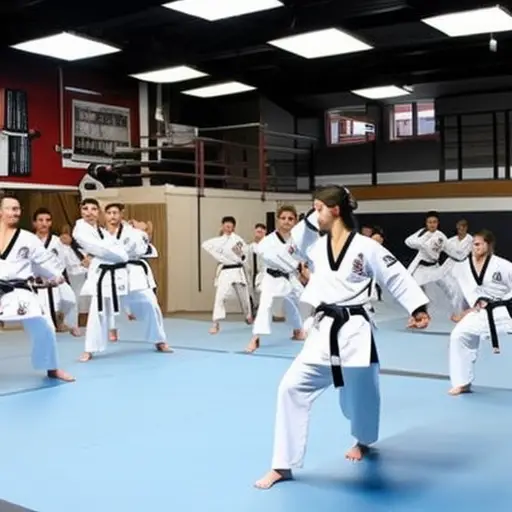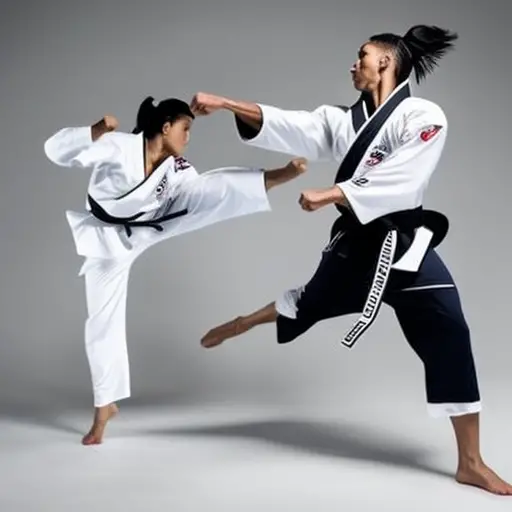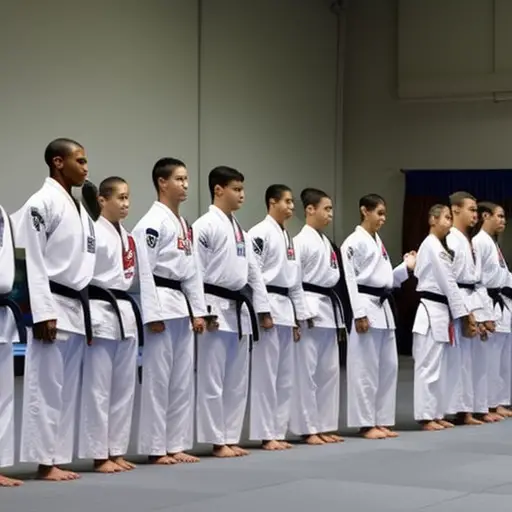Choosing the Right Taekwondo School: Tips and Considerations

In the vast sea of martial arts schools, finding the perfect taekwondo school can feel like navigating through a dense forest. It requires a keen eye to identify the right blend of convenience, expertise, and teaching methods.
This article aims to guide you through the process of choosing the right taekwondo school by offering valuable tips and considerations. From evaluating instructor qualifications to assessing class structure and curriculum progression, we will delve into the key elements that will help you make an informed decision.
Location: Finding a Taekwondo School That Is Conveniently Located for You
When searching for the ideal taekwondo school, it is crucial to consider the location for convenient access and ease of attendance. The convenience factor plays a significant role in ensuring regular attendance and commitment to training.
One of the key factors to consider when evaluating the location of a taekwondo school is its proximity to your home or workplace. Having a taekwondo school that is close to your home or workplace can greatly enhance your training experience. It eliminates the need for long commutes, allowing you to save time and energy that can be directed towards your training. Additionally, a shorter distance to travel means that you are more likely to attend classes consistently, as you won’t have to battle traffic or face other transportation-related challenges.
Proximity to home or work also offers convenience in terms of scheduling. If the taekwondo school is located near your workplace, you can easily fit in a training session during your lunch break or after work. On the other hand, if it is close to your home, you can easily incorporate training into your daily routine without disrupting other commitments.
Considering the convenience factor and the proximity to your home or workplace when choosing a taekwondo school will ensure that you can attend classes regularly and make the most out of your training experience.
Instructor Qualifications: Checking the Credentials and Experience of the Taekwondo Instructors
When choosing a taekwondo school, it is crucial to consider the qualifications and experience of the instructors.
Look for instructors who have the necessary credentials and certifications to teach taekwondo.
Additionally, evaluate their teaching experience and expertise to ensure that they can effectively guide and train students in the art of taekwondo.
Credentials and Certifications
A thorough evaluation of the instructor’s credentials and experience is essential when selecting the right taekwondo school. It is important to consider the certification requirements and the recognized organizations that the instructor is affiliated with.
Look for instructors who hold certifications from reputable organizations such as the World Taekwondo Federation (WTF) or the International Taekwon-Do Federation (ITF). These organizations have established standards and guidelines for instructor training and certification.
Additionally, inquire about the instructor’s experience and teaching background. Find out how long they have been practicing taekwondo and if they have experience teaching students of various ages and skill levels.
A well-qualified instructor will have the necessary credentials, experience, and a strong commitment to providing quality instruction to their students.
Teaching Experience and Expertise
To ensure the highest level of instruction, it is crucial to thoroughly assess the credentials and experience of taekwondo instructors. When choosing a taekwondo school, it is important to consider the teaching methods and instructional techniques used by the instructors. A knowledgeable and experienced instructor can greatly impact the learning experience and progress of students.
To evaluate the teaching experience and expertise of taekwondo instructors, it is recommended to inquire about their qualifications and certifications. Look for instructors who have achieved high-level black belts and have been actively involved in the practice and teaching of taekwondo for several years. Additionally, consider the instructor’s experience with different age groups and skill levels, as well as their participation in competitions and seminars.
To engage the audience, here is a table that can be used to compare the teaching experience and expertise of different taekwondo instructors:
| Instructor | Qualifications | Teaching Experience |
|---|---|---|
| Instructor A | 5th Dan Black Belt | 10 years of teaching experience |
| Instructor B | 4th Dan Black Belt | 7 years of teaching experience |
| Instructor C | 3rd Dan Black Belt | 5 years of teaching experience |
Class Schedule: Assessing the Availability and Flexibility of Class Times
Assessing the flexibility and availability of classes is crucial in finding a Taekwondo school that aligns with your schedule and allows you to make the most of your training. Here are four key factors to consider when evaluating class times and scheduling options:
-
Class Frequency: Look for a school that offers classes multiple times a week to accommodate different schedules. This ensures that you have enough opportunities to attend classes and progress in your training.
-
Time Slots: Consider the variety of class times offered throughout the day. A school with morning, afternoon, and evening classes provides more flexibility, allowing you to choose a time that suits your daily routine.
-
Make-Up Classes: Inquire about the school’s policy on make-up classes. Life can be unpredictable, and sometimes you may miss a class. A school that offers make-up classes or alternative training options allows you to catch up on missed sessions without falling behind.
-
Holiday and Vacation Schedules: Check if the school maintains a consistent schedule during holidays and vacations. Some schools may offer modified schedules during these periods, ensuring that you can continue your training even when your routine is disrupted.
Teaching Style: Understanding the Teaching Methods and Approach Used by the School
The teaching style of a Taekwondo school can greatly impact the learning experience, so it is important to understand the methods and approach used by the instructors. Different schools may employ various teaching techniques to engage their students and help them progress in their Taekwondo journey. Here are some common teaching techniques and their benefits:
| Teaching Technique | Description | Benefits |
|---|---|---|
| Demonstrations | Instructors showcase techniques and forms for students to observe and learn from. | Helps students develop visual understanding and mimic movements accurately. |
| Partner Drills | Students work in pairs to practice specific techniques or sequences. | Enhances coordination, timing, and reaction skills while building camaraderie among students. |
| Sparring | Controlled, supervised combat training between students. | Develops practical application of techniques, improves agility, and fosters a competitive spirit. |
| Forms Training | Students learn and perform a series of predetermined movements in a specific order. | Enhances focus, balance, and precision while building muscle memory. |
| Individual Feedback | Instructors provide personalized guidance and corrections to students. | Helps students refine their techniques and progress at their own pace. |
Understanding the teaching methods and approach used by a Taekwondo school is crucial in finding the right fit for your learning style and goals. Once you have a clear understanding of the teaching style, you can move on to evaluating the class structure: evaluating the size and composition of the classes.
Class Structure: Evaluating the Size and Composition of the Classes
When evaluating the size and composition of Taekwondo classes, two key points to consider are optimal class size and the benefits of student diversity.
Optimal class size ensures that each student receives adequate attention and instruction from the instructor.
Additionally, a diverse composition of students allows for a richer learning experience, as students can learn from each other’s strengths and weaknesses.
Optimal Class Size
While considering the optimal class size for a taekwondo school, it is important to evaluate the size and composition of the classes. The class size can greatly impact the learning experience and overall effectiveness of the training. Here are some key points to consider when evaluating the size and composition of taekwondo classes:
-
Class Size Benefits:
- Smaller class sizes allow for more individualized attention from the instructor.
- Students have more opportunities to practice techniques and receive feedback.
- Personalized instruction helps students progress at their own pace.
- A smaller class fosters a sense of community and camaraderie among students.
-
Class Size Limitations:
- Larger class sizes may result in less individualized attention from the instructor.
- Limited practice time and feedback for each student.
- Difficulty in maintaining discipline and order during training.
- Potential safety concerns due to overcrowding.
Finding the right balance in class size is crucial for creating a positive and effective learning environment in a taekwondo school.
Student Diversity Benefits
Considering the diverse range of students in a taekwondo school, it is essential to evaluate the size and composition of the classes. By doing so, one can reap the benefits of student diversity.
One advantage of having a diverse class is the opportunity for students to learn from each other’s different backgrounds and experiences. This exposure fosters a rich learning environment where students gain a broader perspective and develop cultural sensitivity.
Additionally, a diverse class composition allows for the development of well-rounded taekwondo practitioners who can adapt to different styles and techniques. It also promotes inclusivity and a sense of community among the students.
Furthermore, diverse classes encourage collaboration and teamwork, as students learn to work together despite their differences.
Facilities and Equipment: Examining the Quality and Suitability of the Training Facilities and Equipment
The adequacy of the training facilities and equipment is crucial when evaluating a Taekwondo school. It is important to ensure that the school provides high-quality facilities and suitable equipment for a safe and effective training experience. Here are four key factors to consider when examining the quality and suitability of the training facilities and equipment:
-
Space: A good Taekwondo school should have enough space to accommodate the number of students in each class. The training area should be spacious enough for students to move around freely without the risk of collisions.
-
Flooring: The flooring should be appropriate for Taekwondo training, providing sufficient cushioning to absorb impact and reduce the risk of injuries. It should also have a non-slip surface to ensure stability during training.
-
Equipment: The school should have a variety of equipment such as kicking pads, punching bags, and sparring gear. These should be well-maintained and in good condition to ensure safety and effectiveness during training.
-
Safety Measures: The school should have safety measures in place, such as first aid kits and emergency response plans. Additionally, the training area should be clean and well-maintained to minimize the risk of accidents or injuries.
Considering these factors will help you determine if a Taekwondo school provides the necessary facilities and equipment for effective training.
In the next section, we will discuss the importance of learning about the curriculum and how students progress through the ranks.
Curriculum and Progression: Learning About the Curriculum and How Students Progress Through the Ranks
An essential aspect of selecting the right Taekwondo school is understanding the comprehensive curriculum and the systematic progression that guides students through their journey of advancing ranks and mastering skills. The curriculum of a Taekwondo school typically consists of a series of techniques, forms, and sparring drills that students learn and practice at each level. The progression methods used by different schools may vary, but they generally follow a structured approach to ensure students’ steady growth and development.
To give you a better idea of how students progress through the ranks, here is an example of a typical Taekwondo curriculum and rank requirements:
| Rank | Techniques | Forms | Sparring Drills |
|---|---|---|---|
| White Belt | Basic Strikes and Kicks | Taeguk Il Jang | 1-Step Sparring |
| Yellow Belt | Combinations, Blocks, and Stances | Taeguk Ee Jang | 3-Step Sparring |
| Green Belt | Jumping and Flying Kicks | Taeguk Sam Jang | Free Sparring |
| Blue Belt | Self-Defense Techniques | Taeguk Sa Jang | Continuous Sparring |
| Red Belt | Advanced Kicking Techniques | Taeguk O Jang | Olympic Style Sparring |
| Black Belt | Weapon Forms and Self-Defense | Koryo | Advanced Sparring Techniques |
By following a structured curriculum and meeting the rank requirements, students are able to progress from one belt level to the next, gradually learning more complex techniques and forms. This systematic approach allows students to build a strong foundation and develop their skills over time.
Understanding the curriculum and progression methods of a Taekwondo school is crucial in choosing the right one for your training needs. It ensures that you will receive proper guidance and instruction as you work towards your goals. Now let’s move on to the next section, which discusses the cost of training and available membership options.
Cost and Membership Options: Considering the Cost of Training and Available Membership Options
To make an informed decision, it is important to assess the different cost options and membership plans available when choosing a Taekwondo school. Understanding the training fees and membership plans will help you determine the affordability and value of the school. Here are some key considerations:
-
Training fees: Research and compare the training fees of different Taekwondo schools in your area. Some schools may charge a monthly fee, while others may have a flat rate for a certain period of time. Take into account your budget and ensure that the fees align with your financial capabilities.
-
Membership plans: Taekwondo schools often offer different membership plans to cater to individual needs. These plans may include options for unlimited classes, family discounts, or special packages for beginners. Consider what works best for you and your family, and choose a membership plan that provides flexibility and value for money.
-
Additional costs: Apart from training fees, inquire about any additional costs that may be involved, such as uniform fees, testing fees, or equipment costs. These expenses can add up over time, so it’s important to factor them into your decision-making process.
-
Cancellation policy: It’s crucial to understand the school’s cancellation policy before committing to a membership plan. Find out if there are any penalties or fees associated with canceling or pausing your membership, as this can impact your financial commitment.
Frequently Asked Questions
Can I Join a Taekwondo School if I Have No Prior Experience in Martial Arts?
Yes, you can join a taekwondo school even if you have no prior experience in martial arts. Starting taekwondo as a beginner has several benefits, such as learning self-defense, improving physical fitness, and developing discipline and mental focus.
Are There Any Age Restrictions for Joining a Taekwondo School?
There are typically no age restrictions for joining a taekwondo school, as it is a sport that can be practiced by individuals of all ages. However, starting at a young age can offer numerous benefits in terms of physical and mental development.
Can I Attend Classes on a Drop-In Basis or Do I Need to Commit to a Membership?
When considering attending taekwondo classes, it is important to inquire about the school’s policy regarding drop-in classes versus membership commitment. This will help determine the flexibility in attending classes based on individual preferences and schedules.
Are There Any Additional Fees or Expenses Beyond the Cost of Training?
In addition to the cost of training, prospective students should inquire about any potential additional fees or hidden costs associated with membership, such as testing fees, uniform expenses, or equipment purchases.
How Long Does It Typically Take to Progress Through the Ranks and Earn a Black Belt?
The progression timeline to earn a black belt in Taekwondo varies depending on the individual’s training intensity, dedication, and natural ability. However, on average, it can take anywhere from 3 to 5 years to achieve this milestone.
Conclusion
In conclusion, choosing the right Taekwondo school requires careful consideration of factors such as location, instructor qualifications, class schedule, teaching style, class structure, facilities and equipment, curriculum and progression, as well as cost and membership options. By taking into account these aspects, individuals can ensure they find a school that meets their needs and provides them with the best possible training experience.
As the saying goes, ‘A well-chosen Taekwondo school is like a key that unlocks the door to personal growth and success.’
A well-chosen Taekwondo school is like a key that unlocks the door to personal growth and success, empowering individuals to build self-confidence, discipline, and physical fitness while fostering a sense of community and lifelong friendships.





